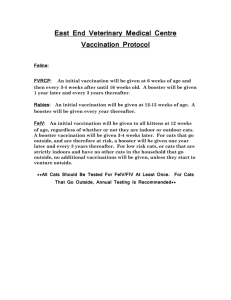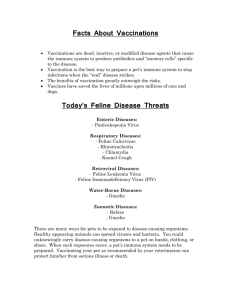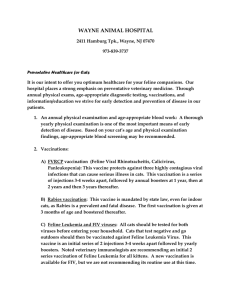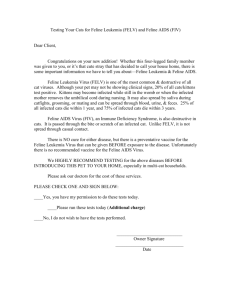feline_rhinotracheitis
advertisement
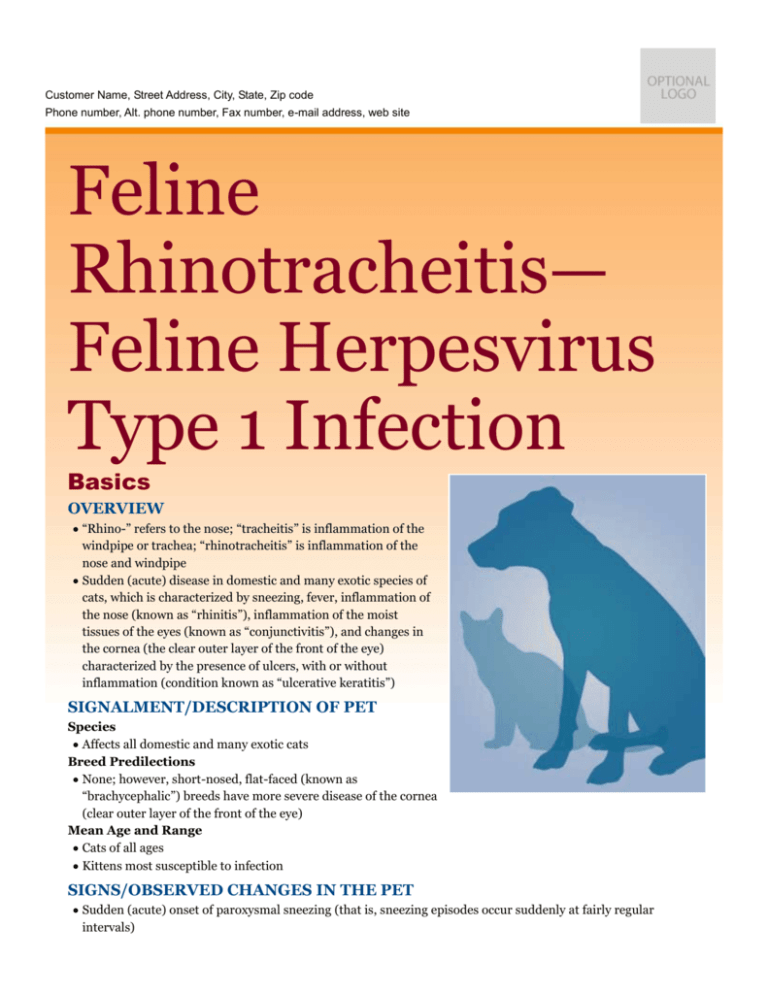
Customer Name, Street Address, City, State, Zip code Phone number, Alt. phone number, Fax number, e-mail address, web site Feline Rhinotracheitis— Feline Herpesvirus Type 1 Infection Basics OVERVIEW • “Rhino-” refers to the nose; “tracheitis” is inflammation of the windpipe or trachea; “rhinotracheitis” is inflammation of the nose and windpipe • Sudden (acute) disease in domestic and many exotic species of cats, which is characterized by sneezing, fever, inflammation of the nose (known as “rhinitis”), inflammation of the moist tissues of the eyes (known as “conjunctivitis”), and changes in the cornea (the clear outer layer of the front of the eye) characterized by the presence of ulcers, with or without inflammation (condition known as “ulcerative keratitis”) SIGNALMENT/DESCRIPTION OF PET Species • Affects all domestic and many exotic cats Breed Predilections • None; however, short-nosed, flat-faced (known as “brachycephalic”) breeds have more severe disease of the cornea (clear outer layer of the front of the eye) Mean Age and Range • Cats of all ages • Kittens most susceptible to infection SIGNS/OBSERVED CHANGES IN THE PET • Sudden (acute) onset of paroxysmal sneezing (that is, sneezing episodes occur suddenly at fairly regular intervals) • Squinting or spasmodic blinking (known as “blepharospasm”) and discharge from the eyes • Lack of appetite (known as “anorexia”)—from high fever, general signs of discomfort and “not feeling well” (known as “malaise”), or inability to smell • Recurrent signs—carriers (cats that have no signs of rhinotracheitis, but harbor the feline herpesvirus and can transmit it to other cats) • Abortion • Fever—up to 106°F (41°C) • Inflammation of the nose (rhinitis)—discharge from the nose; it may be clear or may contain mucus and/or pus • Inflammation of the eyes (conjunctivitis)—discharge from the eyes; it may be clear or may contain mucus and/or pus • Long-term (chronic) inflammation of the nose (rhinitis) and of the sinuses (known as “sinusitis”)—long-term (chronic) discharge from the nose that contains pus; presence of sinusitis cannot be determined without x-rays (radiographs) • Inflammation of the cornea, the clear outer layer of the front of the eye (known as “keratitis”)—ulceration of the cornea; extremely deep ulceration of the cornea, to the inner most membrane of the cornea (known as a “descemetocele”), which may lead to rupture of the eye; or inflammation of all parts of the eye (known as “panophthalmitis”) CAUSES • Feline herpesvirus type 1 (FHV-1) RISK FACTORS • Lack of vaccination for feline herpesvirus type 1; although vaccination may not prevent infection completely • Facilities with multiple cats with overcrowding, poor air exchange (ventilation), poor sanitation, poor nutrition, or physical or psychological stress • Pregnancy and nursing (lactation) • Coexistent disease, especially owing to disease-causing agents that decrease the ability to develop a normal immune response (known as being “immunosuppressive”) or cause other respiratory disease • Kittens born to mother cats (known as “queens”) that have no signs of rhinotracheitis, but harbor the feline herpesvirus and can transmit it (known as “carrier queens”)—infected about 5 weeks of age Treatment HEALTH CARE • Inpatient—nutritional and fluid support to cats with lack of appetite (anorexia); prevent spread of the virus (known as “contagion”) • Outpatient—keep pet indoors to prevent environmentally induced stress, which may lengthen the course of the disease • Fluids—intravenous or subcutaneous (that is, administered under the skin); to correct or prevent dehydration; to keep nasal secretions thin ACTIVITY • Isolate affected cats, because they can spread the virus to other cats (that is, they are contagious) DIET • Outpatient—entice food consumption to avoid lack of appetite (anorexia), which induces a cascade of negative consequences; offer foods with appealing tastes and smells • Inpatients—forced feeding for cats that have lack of appetite (anorexia); carefully clean discharge from the nose (so nasal breathing can occur) before starting tube feeding SURGERY • Surgically implanted feeding tubes may be needed when prolonged lack of appetite (anorexia) occurs Medications Medications presented in this section are intended to provide general information about possible treatment. The treatment for a particular condition may evolve as medical advances are made; therefore, the medications should not be considered as all inclusive • Broad-spectrum antibiotics—ampicillin or amoxicillin for secondary bacterial infections • Antibiotic combinations—ampicillin or amoxicillin and a fluoroquinolone antibiotic (such as enrofloxacin, orbifloxacin, marbofloxacin) for secondary bacterial infections • Lysine may have some effect against the virus; “lysine” is an amino acid (the smallest component of protein); treatment with lysine may decrease eye problems related to feline rhinotracheitis and may decrease the activity of the virus • Antibiotics applied directly to the eye (topical treatment)—for inflammation of the cornea (keratitis) • Medications to eliminate the virus applied directly to the eye (known as “ophthalmic antivirals”)—idoxuridine, trifluridine; for ulcers caused by herpesvirus; must be administered every 2 hours for significant effect • Some evidence suggests that administration of an intranasal vaccine 2–6 days prior to exposure will result in lessening of clinical signs; such use may be helpful in an outbreak in a multicat setting • Famciclovir—early reports indicate effectiveness; expensive Follow-Up Care PATIENT MONITORING • Monitor appetite closely; hospitalize for feeding if lack of appetite (anorexia) develops PREVENTIONS AND AVOIDANCE • Routine vaccination with a modified live virus (MLV) vaccine or inactivated virus vaccine—prevents development of severe disease; does not prevent infection and local viral replication with mild clinical disease and virus shedding • Vaccinate at 8–10 weeks of age; at 12–14 weeks of age; and with boosters for maximum protection, especially in high-risk populations or as directed by your cat's veterinarian • In facilities or households with multiple cats that have cats with feline rhinotracheitis or history of infection— vaccinate kittens with a dose of an intranasal vaccine at 10–14 days of age; then vaccinate using an injectable vaccine at 6, 10, and 14 weeks of age; isolate the litter from all other cats at 3–5 weeks of age; then use kitten vaccination protocol to prevent early infections POSSIBLE COMPLICATIONS • Long-term (chronic) inflammation of the nose (rhinitis) or nose and sinuses (known as “rhinosinusitis”) with long-term sneezing and nasal discharge • Changes in the cornea (the clear outer layer of the front of the eye) caused by herpesvirus infection, characterized by the presence of ulcers, with or without inflammation (condition known as “herpetic ulcerative keratitis”) • Corneal sequestrum (a brown or black lesion involving part of the cornea), which must be removed surgically • Permanent closure of the outflow portion of the drainage system that normally moves tears to the nasal passages (known as the “nasolacrimal duct”) with long-term (chronic) eye discharge EXPECTED COURSE AND PROGNOSIS • Usually 7–10 days before spontaneous remission, if secondary bacterial infections do not occur • Prognosis generally good, if fluid and nutritional therapy are adequate Key Points • Feline rhinotracheitis is a contagious disease, caused by feline herpesvirus type 1 • Proper vaccination protocols and early vaccination to cats in multicat facilities and households are necessary to decrease severity of disease; vaccination does not prevent infection by feline herpesvirus type 1 • Early weaning and isolation from all other cats except littermates may prevent infections Enter notes here Blackwell's Five-Minute Veterinary Consult: Canine and Feline, Fifth Edition, Larry P. Tilley and Francis W.K. Smith, Jr. © 2011 John Wiley & Sons, Inc.

